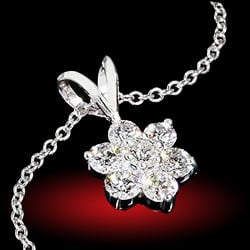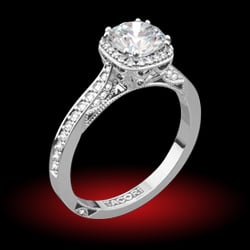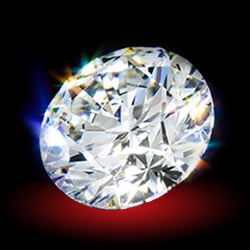faegrace
Shiny_Rock
- Joined
- Feb 24, 2011
- Messages
- 373
Aaahh, The MOHS’ “Hardness” Scale
By Laura Gulij
The Mohs’ Scale of Hardness has been called “relative” and even “arbitrary” by experts in gemology and geology. Why? Read on and see if you don’t agree…
A little history lesson: in 1812 Frederich Mohs selected 10 minerals that were common (in 1812), and arranged them from 1-10 based on scratch tests. As in, number 10 could scratch number 9, number 9 could scratch number 8, etc. 1 is talc, 10 is diamond.
This table is not equally divided, for example a diamond is a “10” and sapphire and ruby are “9”, but diamond is actually 400% harder.
For years, jewelers and the general public have been using this scale like a purchasing bible to determine “hardness” of gemstones. But is ease of scratching the same as toughness? Is a stone that scratches easily a “soft” stone? Is a stone with a higher Mohs number a “tougher” stone?
Some Examples:
Mohs’ Scale: 6-7 GLASS- Think about how tough a GLASS car windshield has to be, or a champagne bottle.
Mohs’ Scale: 5 Your TEETH- “Softer” than Opal, (5.5) With a little care, most of us can get by with the same set for 70 years or so.
Mohs’ Scale: 7.5-8 EMERALD- “Hard” right? Don’t put a large Emerald in a prong-set ring, too brittle. We’ve repaired or replaced lots of those! “Hard” but definitely not TOUGH.
How about this one, Everyone knows PLATINUM is really tough, right? My Grandmother’s ring still looks brand new. Yet, at only 4.5 on the Mohs scale, it is “softer” than practically every gemstone!
So this is what it boils down to: don’t confuse “toughness” with Mr. Mohs’ scale of “hardness”.
To a gem cutter (and repairer), it is all about wearability. For a stone to be a good choice for a ring, it has to be “tough”, not the same as “hard”.
Our top 10 “tough” colored stone recommendations:
Corundum: Ruby, Sapphire,
Garnets: Spessartite, Demantoid,
Zircon
Aquamarine
Spinel
Peridot
Tourmaline*
Tanzanite*
Quartz:* Citrine, Amethyst
Iolite*
*All suitable for rings, but probably best to keep prong settings low, or use somewhat protective settings, ie., low prongs, bezels or channels.
Of course, you can wear anything you want! Especially if you wear a ring occasionally, have the stone protectively set, and/or are very careful. I love my opal channel set ring, have had it 15 years, and still don’t have a scratch on it.
Don’t feel tied to an outdated method of categorizing “wear-able” stones with those to “avoid like the plague”. If you like it, wear it! Just take the proper precautions and you can enjoy it for a lifetime. Like your teeth.
© Gemfix 2011
By Laura Gulij
The Mohs’ Scale of Hardness has been called “relative” and even “arbitrary” by experts in gemology and geology. Why? Read on and see if you don’t agree…
A little history lesson: in 1812 Frederich Mohs selected 10 minerals that were common (in 1812), and arranged them from 1-10 based on scratch tests. As in, number 10 could scratch number 9, number 9 could scratch number 8, etc. 1 is talc, 10 is diamond.
This table is not equally divided, for example a diamond is a “10” and sapphire and ruby are “9”, but diamond is actually 400% harder.
For years, jewelers and the general public have been using this scale like a purchasing bible to determine “hardness” of gemstones. But is ease of scratching the same as toughness? Is a stone that scratches easily a “soft” stone? Is a stone with a higher Mohs number a “tougher” stone?
Some Examples:
Mohs’ Scale: 6-7 GLASS- Think about how tough a GLASS car windshield has to be, or a champagne bottle.
Mohs’ Scale: 5 Your TEETH- “Softer” than Opal, (5.5) With a little care, most of us can get by with the same set for 70 years or so.
Mohs’ Scale: 7.5-8 EMERALD- “Hard” right? Don’t put a large Emerald in a prong-set ring, too brittle. We’ve repaired or replaced lots of those! “Hard” but definitely not TOUGH.
How about this one, Everyone knows PLATINUM is really tough, right? My Grandmother’s ring still looks brand new. Yet, at only 4.5 on the Mohs scale, it is “softer” than practically every gemstone!
So this is what it boils down to: don’t confuse “toughness” with Mr. Mohs’ scale of “hardness”.
To a gem cutter (and repairer), it is all about wearability. For a stone to be a good choice for a ring, it has to be “tough”, not the same as “hard”.
Our top 10 “tough” colored stone recommendations:
Corundum: Ruby, Sapphire,
Garnets: Spessartite, Demantoid,
Zircon
Aquamarine
Spinel
Peridot
Tourmaline*
Tanzanite*
Quartz:* Citrine, Amethyst
Iolite*
*All suitable for rings, but probably best to keep prong settings low, or use somewhat protective settings, ie., low prongs, bezels or channels.
Of course, you can wear anything you want! Especially if you wear a ring occasionally, have the stone protectively set, and/or are very careful. I love my opal channel set ring, have had it 15 years, and still don’t have a scratch on it.
Don’t feel tied to an outdated method of categorizing “wear-able” stones with those to “avoid like the plague”. If you like it, wear it! Just take the proper precautions and you can enjoy it for a lifetime. Like your teeth.
© Gemfix 2011







300x240.png)